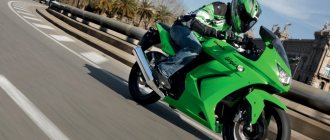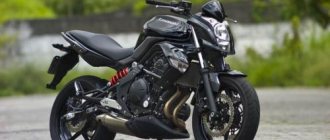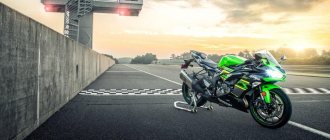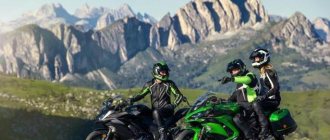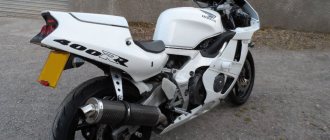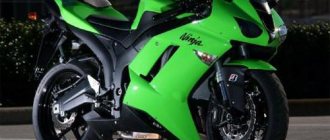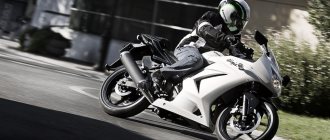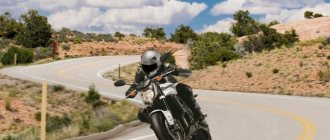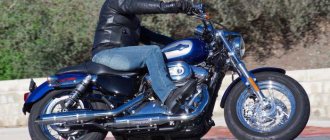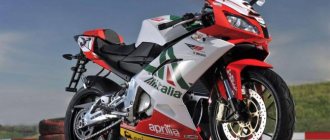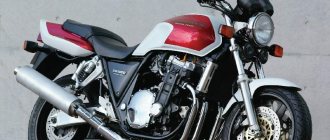In 2006, the Japanese brand Kawasaki launched the ER-6 model. It is classified as a road car and is positioned as a replacement for the previously released ER-5. If you tell the story, it was this year that environmental standards were tightened and 5 did not comply with them.
It was possible to reconfigure its engine and produce a model that was still successful. But the developers decided otherwise. Unlike the 5, the new product had to conquer not only Japan, but also other countries/continents. And the ER-5 was already an “old lady”. Released unchanged for 10 years + one feature that the creators didn’t particularly like. Therefore, it was only a matter of time before a new bike appeared.
However, it turned out that it is not only time that delays the new product. Since it was supposed to appear in all countries at the same time, company representatives began to argue - what should it be called?
Name confusion
Kawasaki-ER-6-N – naked version of the motorcycle.
Kawasaki-ER-6-F – tourist version in full plastic.
The Japanese were laconic - if the previous one was ER-5, then its update should be called ER-6 . But the marketing department came up with a proposal to make two variations - naked (like the 5) and full plastic in the sport-tourist style.
The new solution was limited to only adding one letter - N for naked , F for tourist .
The final confusion was caused by the American department - our user does not buy naked shoes! We will only sell the plastic version. And ER is not a name either. Dealers will be offering the Kawasaki Ninja 650R.
And so it happened - despite the fact that a couple of years after the start of production, the Americans wanted a naked version - one motorcycle had as many as three names .
Closing production and future plans
The bike was produced until 2021 . In the new year 2021, the Japanese manufacturer closed both versions. They were replaced by the Kawasaki Z650 (naked) and Kawasaki Ninja 650 (tourist).
Every year, new items receive minor cosmetic changes.
Brief history of the model
- 2017 - start of production and sales of the model. First generation.
Model
: Kawasaki Ninja 650 + ABS (all regions).
Factory designation
: EX650JHF + EX650KHF.
- 2018 - no significant changes.
Model
: Kawasaki Ninja 650 + ABS (all regions).
Factory designation
: EX650JJF + EX650KJF.
- 2019 - no significant changes.
Model
: Kawasaki Ninja 650 + ABS (all regions).
Factory designation
: EX650JKF + EX650KKF.
- 2020 - restyling of the model. Second generation
.
Model
: Kawasaki Ninja 650 + ABS (all regions).
Factory designation
: EX650NLF + EX650MLF.
- 2021 - no significant changes.
Model
: Kawasaki Ninja 650 + ABS (all regions).
Factory designation
: EX650NMFNN + EX650MMFNN.
Specifications
Since the ER-6 was still considered an update, its engine did not receive any special differences, unless you take into account the injector, EURO-3 compliance, and more economical (according to the developer) fuel consumption.
Engine – right side view.
Engine – left view.
The number of cylinders, strokes, valves remains unchanged:
- working volume - 649 cm3;
- number of cylinders - 2 (in-line arrangement of pistons);
- number of cycles - 4;
- number of valves - 8 (4 per cylinder);
- power - 72.1 hp;
- torque - 66 (64) Nm;
- cooling - liquid;
The cooling radiator in the tourist version is hidden between the side fairings, as is almost the entire engine.
- fuel supply - injector (TTK 38, Keihin);
- ignition - transistor (TDI);
- start - electric starter;
- tank volume - 16 l.
In 2012, the motorcycle was updated and the engine was retuned. The maximum torque has become less, but its curve has leveled out, and at medium speeds this gave a good increase in dynamics.
Transmission and clutch
The motorcycle received a 6-speed gearbox. It worked smoothly and did not create any problems for the user.
The main drive is a classic chain drive.
Finding the right gear or neutral was no problem. It had several features:
- quite loud switching sound (users note that all motorcycles of the brand have this to varying degrees);
- easy switching, soft;
- elastic : 40 km in 6th gear? Why not! 120 to 1? Yes please!
She had a kind of foolproof protection. If the bike is in first gear and stops, second gear will not engage, only neutral.
- Multi-disc clutch , oil bath . Power transmission is a cable .
- The main drive is a chain .
Brakes
A fundamental change in the model occurred here. The motorcycle received disc brakes on both the front and rear axles. Drive - hydraulics.
Front brakes – 2 discs.
Rear brakes – 1 disc.
Front:
- number of disks - 2;
- disc diameter - 300 mm;
- support - 2-piston.
Rear:
- number of disks - 1;
- disc diameter - 220 mm;
- support - 1-piston.
Since 2007, it has become possible to install ABS as an option. It was not included in the stock configuration - when ordering in the showroom, the user had to arrange this separately. The choice was given - for any one wheel, or for both. This will only appear in stock in future developments.
REVIEW – Kawasaki Ninja 650 – a universal bike for all occasions
Buy Ninja 650 here
Best price guarantee!
The updated Kawasaki Ninja 650 instantly grabs attention with its all-new design and frame, making it an interesting bike for a wide range of riders. Indeed, I would like to understand what this device can offer the owner.
The bike is a bright representative of its cubic capacity class and, due to its reasonable engine power, allows you to focus more on technical piloting rather than on keeping the motorcycle in check. A modest and fairly responsive engine of 67 horsepower will help the rider to fully immerse himself in honing his riding skills, and at the same time see whether the younger brother from the Ninja family can excite and evoke an emotional response similar to the older ZX-6R, or even the “head of the family” the mighty ZX-10R.
But at the same time, I want to understand how convenient, practical and easy the Ninja will be to manage and use in everyday use. Stuffed up sportbikes tend to be quite uncompromising and edgy, focused solely on getting the best time on the track in the shortest possible time. The Kawasaki Ninja 650 is a motorcycle with a slightly different purpose, and it is useful for a potential owner to know how to find compromises with this motorcycle, whether it is used exclusively as a track tool or whether it is also convenient for everyday life.
In the photo: slender and swift Ninja 650 KRT Edition
Look into the future
Recently, there has been a surge in the production of medium-sized motorcycles with a sporty look and average power; they are becoming a kind of mainstream among manufacturers and buyers. With the new Ducati Supersport S launched, Honda plans to halt production of its popular razor CBR600RR to focus instead on the softer CBR650F and more practical CBR500R. Is it safe to believe that the Ninja 650 is part of this shift in direction, and mid-size sportbikes are the future?
Every rider has their own fantasy garage full of all sorts of expensive exotic bikes, but the harsh reality is that many of these bikes are not always available to riders. Moreover, most often these are not the motorcycles that owners would like to use on a regular basis. In these conditions, the mid-sized Kawasaki is well within the reach of many motorcyclists. And this is actually a good choice: it will not require additional costs for electronic add-ons, it has a completely finished image and endless catalogs of accessories will not bother the owner's soul, it is just a motorcycle, clean and understandable, and these are very good qualities for an everyday bike.
In the photo: put on gloves and go! Great weather for a motorcycle ride!
Track
A fan of fast riding, when reading this article, will be left wondering what this motorcycle is capable of on the track; is it really possible to combine a comfortable city bike with a racing machine?
In Belgium there is one of the fastest racing tracks in the world, Spa Francorchamps, and it was there that we had the opportunity to test this interesting model.
It is fair to say that this test drive went beyond the usual use of this bike. The Ninja 650 has a good amount of power with its honest 67 horsepower, while many of its peers in this class produce no more than forty.
Perhaps the somewhat limited power of the motorcycle will not be able to reveal all the delights of high-speed flight along a long straight track, but in turns and bends the bike allows you to frolic to your heart's content.
In the photo: passing a bend
Peculiarities
The only suspension adjustment is preload in the rear shock absorber. It was assumed that to access the regulator it would be enough to simply remove the side decorative panel, but this turned out to be quite difficult. It turns out that this is almost impossible to do without removing a number of elements, which can cause some inconvenience when operating the bike. The future owner should pay attention to the presence of such a design feature.
The installed Roadtec Metzeler 01 tires performed track hours much better than expected. These tires are not intended for track racing and would not last long on a more powerful bike. When installed on a Ninja, they can surprise and bring many pleasant moments to the rider.
The bike’s brakes differ from those of its more powerful brothers; in the urban cycle they behave confidently and adroitly, but in track riding mode you want more. Perhaps you should choose a different set of pads: the ones originally installed were not intended for this use.
The low weight of the motorcycle allows you to easily and naturally turn it into turns at fairly sharp angles and, despite the only adjustment in the suspension, makes it possible to quickly navigate the bends of the track.
In the photo: very good turning angle
The bike's footpegs caused a mixed feeling - the high-quality rubber coating perfectly softens engine vibrations and would be appropriate on more powerful motorcycles. The example presented suggests stiffer pegs to improve feedback from the bike. As for the passenger footpegs, the right one is almost in the path of hot exhaust gases, which can melt it during a long race.
Despite some nuances, the motorcycle is perfectly balanced, behaves energetically and cheerfully in the urban cycle and on the race track, so we can safely recommend it for purchase and use. It is lightweight, universal in use and is guaranteed to bring a lot of pleasant impressions to its owner.
And finally, a number of technical characteristics of the updated Kawasaki Ninja 650:
Engine : 649 cubic meters, two-cylinder with parallel arrangement of cylinders.
Claimed power : 67 horsepower
Claimed torque : 61 Nm.
Frame : tubular steel.
Weight : 193 kg.
Fuel tank capacity : 15 liters.
Front suspension : conventional fork, not adjustable.
Rear suspension : single shock absorber, adjustable spring preload.
Front brake : Two discs with a diameter of 300 mm with two-piston calipers, ABS.
Rear brake : single 220 mm disc, single-piston caliper, ABS.
Driving performance
The motorcycle has enough dynamics to quickly and confidently accelerate to cruising speed.
The developers rounded the maximum speed 200 km/h . It’s curious that if the conversation turned to the plastic version, they said more for it - 205 km/h .
According to users, 160 km/h is gained imperceptibly. Then it just blows away - you have to cling to the tank . Comfortable cruising - 120–130 km/h .
In terms of acceleration, the bike does “R6 (Yamaxa)”. From zero to 100 km/h in 3.8 seconds.
Fuel consumption
Fuel consumption declared by the developers is 3.5 liters in the combined cycle. Users note that the figure is less than the real one.
On Russian roads at one gas station no more than 350 km .
Approximately 4.5-5.5 liters per 100.
Dimensions and weight
The dimensions of different motorcycle models differ slightly - the “naked” version is lighter and more compact than the touring version.
During the evolution of the model, the weight of the bike increased by 10 kg.
The first editions of the naked weighed 196 kg of curb weight, the tourist - 200 kg . The appearance of ABS, updates in 2012 (by changing the torque), a number of cosmetic changes and the naked weight of the last years of production became 204 kg of net weight, 206 kg with ABS.
The tourist respectively received - 209 kg and 211 kg .
The sizes did not change so significantly:
insignificant:
- in length - from 2,100 to 2,111 (2105) mm;
- width - 760 (771) mm;
- in height - 1,094–1,111 (1211-1180) mm;
Seat height - 786–806 (790) mm .
Wheelbase - 1405 (1410) mm .
The dimensions of a naked bike are given, with those of a tourist in parentheses.
For whom is it intended?
Even a short girl feels confident in the saddle of a bike.
Since the bike was supplied to all markets (including Japan), it could not have a high seating position by definition.
Europeans oh, and then, after sitting in the saddle, “... but how comfortable.”
People over 180 cm will also find it comfortable. “Feet don't just stay on the ground. I can bend my knees."
2008 KAWASAKI NINJA® 650R SPORTY PERFORMANCE MEETS GREAT HANDLING
Average, practical, capable, powerful and fun to drive
With its winning, modern design and performance versatility, it's no wonder the 2008 Kawasaki Ninja® 650R stands out among other motorcycles on the road. Sportbike-level power and a comfortable ride are a rare combination - the Ninja 650R is great for city riding, long weekend trips and mastering the race tracks.
Its versatility is a good thing, because the more time bikers spend on the Ninja 650R, the stronger their desire to just ride - for any reason or even no reason. When developing this bike, the Kawasaki team began with a unique approach of focusing all their efforts on the rider, not the bike, and thus the new 650R was born, quickly gaining popularity.
A key component to the Ninja 650R's optimal sizing is its compact, liquid-cooled, DOHC, 8-valve, 649cc parallel twin with digital fuel injection. The engine immediately inspires confidence in new riders. Its power take-off and smooth, responsive performance are always tuned to a friendly touch. Excellent mid-range performance makes the 650R a natural fit in any traffic, no traffic jams will be a problem thanks to its lightweight trellis frame and good handling.
The 650R's engine can be tuned for both luxurious highway riding and friendly racing.
Kawasaki's highly experienced engineers have skillfully and professionally designed the Ninja supersport motorcycles to deliver performance features consistent with the mid-weight class of motorcycles, including those equipped with larger displacement engines. The Ninja 650R is a precision-proportioned motorcycle that will make both new and experienced bikers feel right at home. It is equally convenient for both everyday business trips and Sunday outings.
Peculiarities
— Aggressive Ninja styling — Powerful parallel twin — Compact size and weight combination — Low seat height
Engine – 649cc parallel twin DOHC engine – The most compact engine in its category, smaller even than the Ninja 500 model, which helps to reduce the size of the entire motorcycle – Engine tuning is aimed at increasing power in the lower and mid-range. — The triangular design of the crankshaft and transmission shaft significantly shortens the engine, the semi-dry sump helps reduce the engine height, and the small distance between the cylinders reduces the engine width. The cylinders are linerless and coated with aluminum to reduce weight. - Muffler with three-stage catalytic converter is located under the engine to help centralize mass and lower the center of gravity - 180-degree crankshaft and balance shaft for exceptionally smooth engine operation - Oil jets on the connecting rod ends spray oil under the pistons to keep them cool
Liquid Cooling - Routing cooling pipes through cases for a cleaner appearance. - Maintains constant operating temperature for extended engine life and consistent power during hard driving - Allows tight engine clearances for more power
Digital Fuel Injection - Sub-throttle valves in 38mm Keihin bodies provide optimal performance and reliability - Located behind the main throttle valves, the sub-throttle valves are controlled by the DFI® ECU for enhanced throttle response, similar to a constant speed carburetor - Auto Idle for easy starting and warming up the engine - Precise fuel injection plus an exhaust catalyst significantly reduces emissions
Digital Capacitor Ignition (CDI) - Microprocessor controlled ignition timing system requires no tuning and is highly responsive to engine requirements - Plug-mounted ignition coils are compact and help reduce weight
Six-Speed Transmission - Cassette-type transmission with transmission shafts and shifters in one compact package that can be easily removed from housings for maintenance
Lattice Frame - High-strength steel trellis frame - compact and lightweight - Optimal balance of stiffness for superior handling characteristics, achieved using 3D computer modeling and engineering analysis - Narrow knee and foot area for rider comfort and control
Rear Suspension, Monoshock - Short, compact frame and engine design allows for a longer swingarm and improved overall handling - The rigid swingarm and rear monoshock complement the sleek look from handlebar to rear wheel hub
Tri-petal brake rotor design - Petal rotor design - similar to its supersport siblings the Ninja ZX-6R and ZX-10R
— With improved cooling and wear resistance characteristics
6-Spoke Wheels - Six-spoke design, same as on the Ninja ZX-6R and ZX-10R models, requires much less material between the spokes for a thinner rim and lighter rider
- Confidence -inspiring cockpit - Low, narrow seat combined with the bike's narrow overall design allows riders to easily keep both feet on the ground when stopping - Carefully designed ergonomics translate to a natural, comfortable riding position - Textured seat cover promotes a better riding position
Body - Stylish, streamlined, with an aerodynamic windshield that protects the rider - Integrated front turn signals enhance the bike's appearance
basic information Model: Kawasaki Ninja 650R Year: 2008 Type: Sportbike Motor and drive Working volume: 649 cm3 Type: In-line four Bars: 4 Compression: 11.3:1 Bore x Stroke: 83.0 x 60.0 mm (3.3 x 2.4 inches) Power: 71.00 hp (51.8 kW)) Torque: 48.50 Nm (4.9 kgf-m / 35.8 ft.lbs) @ 7000 rpm Fuel system: Injection Valves: 4 Fuel control: DOHC Engine starting: Electric starter Ignition: Digital CDI Cooling: Liquid Transmission: 6 speed Drive unit: Chain Dimensions Weight: 178.3 kg Height: 1270 mm Length: 2106 mm Width: 759 mm Ground clearance: 145 mm Seat height: 790 mm Chassis Wheelbase: 1410 mm Frame: Semi-double cradle, high-tensile steel Fork angle: 25.0° Trail: 107 mm Front shock absorber: 41mm hydraulic telescopic fork / 4.7 in. Rear shock absorber: Single offset laydown shock with adjustable spring preload / 4.9 in. Colors: Lime Green, Sunbeam Red, Metallic Diablo Black Speed and acceleration Max. speed: 220.5 (137.0 mph) Power/Weight: 0.3993 hp/kg Other Gas tank capacity: 15.51 l. Front tire: 120/70-ZR17 Rear tire: 160/60-ZR17 Front brake: Double disc. Dual 300mm Petal Disc with 2-Piston Caliper Front brake diameter: 300 mm Rear brake: Single disc. Single 220mm Petal Disc with hydraulic caliper Rear brake diameter: 220 mm Exhaust: Two Into One Under Engine Translation MotoSvit
Modifications
In addition to the two basic configurations, the ER-6 became the progenitor for 2 more models of the brand.
Modification of Kawasaki Versys 650.
Modification of Kawasaki ER-4.
In 2007, the Kawasaki Versys 650 touring-enduro entered the production line. In terms of filling, it differed little. The main changes were in the suspension and cosmetics.
It received an inverted fork, longer strokes, and increased overall dimensions. The result is lower speed and weaker dynamics. With a tank of 21 liters , the declared consumption does not exceed 5 liters .
But also in 2010, the Kawasaki plant in Thailand began producing the Kawasaki ER-4 . Essentially this is the same ER-6, but with a weaker engine. Assembled for Japanese domestic markets.
Competitors
But the situation with competitors is unusual. Although the ER-6 is one bike, but in a different configuration, representatives of other “Japanese” called the models different and presented their answers for each - for the ER-6n and ER-6f.
For ER-6n
Honda NC700.
Suzuki SFV650 Gladius.
Yamaha MT-07.
Honda NC700 (NC750)
- road builder + enduro tour;
- start of production in 2012 ;
- the engine is the same, but tilted forward - 55°;
- volumes - 669 and 745;
- in both cases the injector is of our own design;
- release continues.
A distinctive feature was the single-disc front brake, but with the possibility of obtaining a combi-brake (both are activated when the handle is pressed) as an option.
Suzuki SFV650 Gladius
- naked;
- start of production - 2009 ;
- 2 cylinders in V-shaped design;
- pumping 645 cm³ ;
- closed in 2015 .
The main distinguishing feature was SDTV - 2 dampers in the cylinders.
Yamaha MT-07
- naked;
- start of production - 2014 ;
- the engine is a complete analogue of Kawasaki;
- exhaust 689 cm³ ;
- production continues.
The difference is 4 pistons on the front brake disc and digital ignition
For ER-6f
Honda CBF600S.
Suzuki GSX650F.
Yamaha XJ6 Diversion.
Honda CBF600S
- naked in plastic (sport-tourist);
- production started in 2004 .
- engine capacity - 599 cm³ ;
- injector of our own design (since 2008);
- closed in 2013.
The main difference was the engine - 4 cylinders.
Suzuki GSX650F
- sports tourist;
- start of production - 2008 ;
- engine capacity - 656 cm³ ;
- closed in 2021.
The main differences were SDTV , a 4-cylinder engine and brake calipers (4 pistons per disc for the front axle, 2 for the rear).
Yamaha XJ6 Diversion
- sports tourist;
- start of production - 2009 ;
- engine bypass - 600 cm³ ;
- closed in 2017 .
The difference is a 4-cylinder engine and digital ignition.
Model features and design
The design feature of the new Kawasaki Er-6n is an “anti-fashion movement”.
Manufacturers try to liken the appearance of many road motorcycles to superbikes, trying to increase their attractiveness to buyers.
Other models are made in the popular minimalist style of the 1970s.
The Kawasaki Er-6n differs from both of them in its original design, which claims to predict the style of naked motorcycles of the next 5-6 years.
The Er-6n doesn't have the outstanding racing fairings of its competitors, but it's unique compared to them. Especially considering the original matte coating on the painted parts and the chrome exhaust pipe.
Advantages of the model:
- Narrowed body for comfortable city driving;
- Torquey and economical 2-cylinder engine;
- Modern braking system;
- Reasonable price compared to competitors.
Kawasaki's lineup includes two sister models: the Er-6n and the Er-6f.
The technical base of the motorcycles is almost the same.
The main difference is the more aggressive and sporty design of the Er-6f and the presence of wind fairings. This improves the riding comfort of the motorcycle at high speeds.
But Er-6n, while not inferior in terms of technology, will cost the buyer more than 1000 euros less.
The color range of Kawasaki Er-6n motorcycles includes many colors to suit every taste: green, red, black, white and others.
Peculiarities
A key feature of the suspension is the rear mono-shock absorber shifted to the side.
Users noted the following features of the ER-6:
- Quiet exhaust . “The car next to me makes more noise than me.”
- Constantly running cooling fan . “There are no temperature indicators on the panel, but it works”... out of precaution.
- Additional gearbox functions and flexibility in gear selection.
- Wide steering wheel.
Tuning features
Every owner wants his bike to have a unique styling. To achieve this result, tuning is used. It can be external, engine tuning and chassis. External work includes painting, replacing fairings, handles, stickers, and mirrors. It is done mainly for “show-off” or to give the motorcycle an aesthetic appearance. A motor conversion is an improvement in the power output of a bike by replacing some of the factory parts with others or eliminating them if necessary. When the chassis is replaced, the wheels, brake system, clutch, suspension, or, in other words, everything that can improve its technical capabilities are replaced.
Tuning the appearance of the Kawasaki ER-6N. Profile view.
Flaws
No obvious disadvantages were noticed, but what I would like to change (due to nitpicking):
- Weak bulbs in the headlight. The closest one is nowhere, the farthest one is a little better. Changed by installing xenon
The naked bike has one irregularly shaped headlight.
In the tourist version there are two fox eyes.
- Vibrations . Any gear, any speed - the motorcycle vibrates. On trips over short distances this doesn’t really bother us (vibration is not transmitted to the controls), but on long trips it just gets annoying. Unfortunately, another feature of the motor is incurable.
- Wide steering wheel . Although the bike is quite narrow, a wide handlebar will not allow you to “shoot through the aisles.”
Advantages
Well-designed side wind protection allows you to feel comfortable at fairly high speeds.
The owners include:
- Inexpensive maintenance . “This is exactly the case when it’s better to pay but get quality.”
- Large selection of components.
- Maintainability . A minimum of electronics, simple parts, no “abstruse patented technologies.”
- Good mirror spacing.
- Low saddle at the same time it reduces external dimensions and allows you to ride comfortably (although not many people like the forward-leaning seating position). And the fabric upholstery will not allow you to move out during acceleration/maneuvers.
The rear suspension of the motorcycle leaves much to be desired. If there are no problems with a light passenger, then with a larger load, the release is triggered on uneven surfaces.
Advantages of the bike
Here are the main advantages of this wonderful model:
- high speed with good handling;
- design at the art level;
- excellent filling, putting it on a par with the advanced motorcycles of the time.
The motorcycle has several distinctive features. An electronic system is used to start the engine. The frame of the motorcycle is of the “birdcage” type. As for the rest of the features, they are very typical for classic bikes. But at the same time, these features are better than most motorcycles in this class.
The Kawasaki Ninja 650 R is an excellent example of a motorcycle of medium ambitions. Despite the sporty design, this is not a super-fast bike, it is an ordinary classic motorcycle that sets the bar for quality in its niche.
